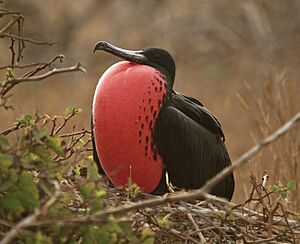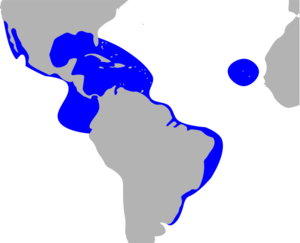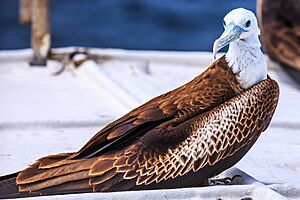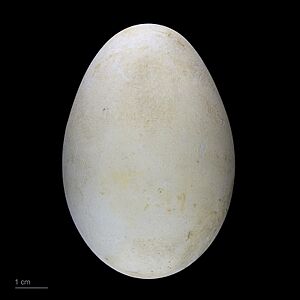Magnificent frigatebird facts for kids
Quick facts for kids Magnificent frigatebird |
|
|---|---|
 |
|
| Male Fregata magnificens magnificens with inflated gular sac, Española, Galápagos | |
 |
|
| Female Fregata magnificens rothschildi, Panama | |
| Conservation status | |
| Scientific classification | |
| Genus: |
Fregata
|
| Species: |
magnificens
|
|
|
 |
|
| Range map | |
The magnificent frigatebird (Fregata magnificens) is a cool seabird that belongs to the frigatebird family. It's the biggest frigatebird, growing up to 114 centimetres (3 ft 9 in) long. Its wings can spread out to 2.44 m (8 ft 0 in) wide!
You can find these birds flying over warm, tropical waters. They live along the coasts of America, from Mexico down to Perú on the Pacific side. On the Atlantic side, they are found from Florida all the way to southern Brazil. They also live on the Galápagos Islands and the Cape Verde islands.
Magnificent frigatebirds are lightweight birds with brownish-black feathers. They have long, narrow wings and a tail that splits deeply like a fork. The male birds have a bright red throat pouch that they blow up like a balloon to impress females. Females are a bit bigger and have a white chest and belly. These birds mostly eat fish they catch from the ocean's surface while flying. They are also known for stealing food from other birds!
Contents
About the Magnificent Frigatebird
The magnificent frigatebird is a large, graceful seabird. It has a sleek body and very long wings. These birds are known for their amazing flying skills. They can stay in the air for days without landing.
They often catch flying fish right out of the water. Sometimes, they even chase other birds. They do this to make the other birds drop their food. Then, the frigatebird swoops down to catch the meal! This trick is called kleptoparasitism.
Frigatebird Family Tree
Scientists first thought the magnificent frigatebird was the same as another species, Fregata aquila. But in 1914, a scientist named Gregory Mathews suggested it was a unique species. He gave it the scientific name Fregata magnificens.
There are five types of frigatebirds in the world. Genetic studies show that the magnificent frigatebird is most closely related to the Ascension frigatebird.
Different Types of Magnificent Frigatebirds
There are two main groups, called subspecies, of the magnificent frigatebird:
- F. m. magnificens: These birds live and breed on the Galápagos Islands.
- F. m. rothschildi: These birds breed on islands off the Pacific coast of Mexico and Central America. They also live in the tropical Atlantic Ocean, from Florida south to Brazil. You can also find a few on the Cape Verde islands.
For a long time, scientists thought these two groups were the same. But in 2022, new studies showed they are different. Scientists looked at their genes and how they look. They found that the Galápagos frigatebirds are special. They haven't mixed their genes with mainland frigatebirds for hundreds of thousands of years! This means they are quite unique.
History of the Frigatebird Name
The famous explorer Christopher Columbus saw magnificent frigatebirds in 1492. He was near the Cape Verde Islands on his first trip across the Atlantic. In his journal, he wrote about a bird that made other birds throw up their food. He noted it was a seabird that didn't land on the water.
The name "frigatebird" comes from French sailors. They called the bird La Frégate. This means a fast warship, like a frigate. The birds are very fast and agile, just like those ships!
In 1697, an English explorer named William Dampier called them "Man-of-War birds." He wrote about how they fly high like a kite. When they spot food, they dive fast to catch it without touching the water. He also noted their very long wings.
The word Fregata for the genus name also comes from the French word for a warship. The word magnificens is Latin for "splendidly" or "grand." So, it's a "splendid warship bird"!
Where Magnificent Frigatebirds Live
The magnificent frigatebird lives in many tropical places. They breed in colonies, often in trees on islands and small land areas called cays. These places often have mangrove trees.
You can find them in Florida, the Caribbean, and along the Pacific coast of the Americas. This includes places from Mexico down to Ecuador. They are also famous residents of the Galápagos Islands.
Sometimes, these birds fly far away from their usual homes. They have been seen in places like the Isle of Man, Denmark, Spain, and even British Columbia in Canada! These birds are called vagrants when they appear in unusual locations.
What Magnificent Frigatebirds Look Like
The magnificent frigatebird is the biggest of all frigatebirds. It can be up to 114 cm (3 ft 9 in) long. Its wingspan can reach 2.44 m (8 ft 0 in), and it weighs about 1.59 kilograms (3 lb 8 oz).
Male birds are all black. During breeding season, they have a bright red throat pouch that they inflate like a big balloon. Their black feathers can look purple and shiny in the sunlight. Female birds are black too, but they have a white chest and lower neck. They also have a brown band on their wings and a blue ring around their eyes. This blue eye-ring helps tell them apart from other frigatebirds. Young birds have a white head and white underparts.
These birds are very similar to other frigatebirds. But they don't have a white patch under their wings. Young birds have a special diamond-shaped white patch on their belly. Magnificent frigatebirds are usually quiet when they fly. But at their nests, they make rattling sounds.
They can spend days and nights flying! They flap their wings about 2.84 times per second. They can fly at about 10 km/h (6.2 mph) and travel up to 223 km (139 mi) before landing. They often ride warm air currents, called thermals. They can climb as high as 2,500 m (8,200 ft) in the sky! Then they glide down close to the ocean surface.
Frigatebird Behaviour
Reproduction and Nesting
Magnificent frigatebirds build simple nests. They make a flat nest from branches and twigs. They build these nests on top of trees and bushes on islands and cays. These places often have mangrove trees.
The female bird lays one clear white egg. The egg is about 68 by 47 millimetres (2+3⁄4 by 1+3⁄4 in) in size. Both parents take turns sitting on the egg for about 50 to 60 days. After the chick hatches, the male parent leaves. The female stays to feed and care for the young bird for almost a year!
How Frigatebirds Find Food
These birds mainly eat fish, squid, jellyfish, and crustaceans. What they eat can change based on what food is available. It also depends on how they like to hunt, and if they are male, female, or young.
As mentioned, they are also kleptoparasites. This means they steal food! They peck at other seabirds to make them throw up their meals. Once the other bird regurgitates its food, the magnificent frigatebird dives. It catches the meal before it even hits the water!
Protecting Magnificent Frigatebirds
The magnificent frigatebird is currently listed as a species of "Least Concern" by the International Union for Conservation of Nature. This means they are not in immediate danger of disappearing.
However, the population on the Galápagos Islands is special. These birds are genetically unique. There are only about two thousand magnificent frigatebirds that nest there. This small group is vulnerable. Any big natural disaster or human threat could harm them greatly. Because they are so unique, scientists might need to give them a special conservation status.
The population on the Cape Verde islands is also very small. It's thought to be close to disappearing. Protecting the places where these frigatebirds breed is very important for their survival.
Images for kids
-
Male with partial inflated throat pouch
-
Male, Mexico
-
Female, Panama














